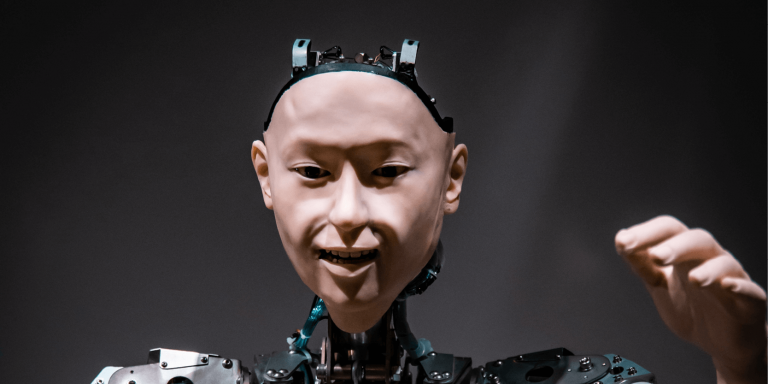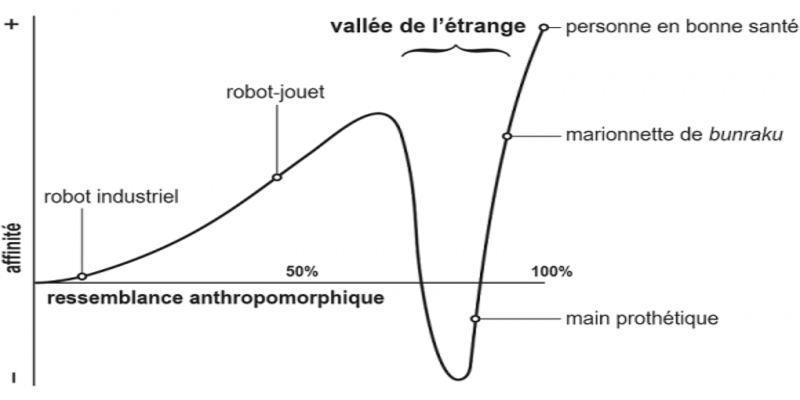
Current technological advances are pushing us further from fiction to a reality that is both tangible and artificial. Machines, prostheses, and other robotic devices invade our daily life. But the human eye cannot be deceived. Because well beyond our consciousness, we cannot tolerate what looks like us, but is not us. An overview of the concept of the Valley of the Strange, also called the Valley of the Disturbing.
A robotics engineer invents a very current scientific concept
Our story begins in 1978, when Masahiro Mori, a robotics engineer, defined, for the first time, the concept of the Valley of the Strange. At first, machines with artificial intelligence were just metal formations. There was no similarity, even remotely, with a person. Today, however, it is possible for science to faithfully reproduce a human body, with all its characteristic features.
In essence, this notion of the “Valley of the Weird” takes into account the fact that if a robot has too strong an anthropomorphic resemblance to us, a feeling of unease appears. Note that this phenomenon does not only apply to robots, but also to prostheses or dolls. To build a clear visual of this concept, we can refer to the image below:

As we can see, the Valley of the Weird phenomenon can be visualized by a graph, where the ordinates represent familiarity (or sympathy), and the abscissa the degree of anthropomorphism. We are talking about a valley here, because beyond a certain level of perfection in resemblance, android objects become more and more accepted.
However, if the human-machine resemblance is too strong, the feeling of empathy turns into a great repulsion. If we want to get a concrete idea of the concept of the Valley of the Weird, we can refer to a study that was conducted on this subject by a team of researchers from the University of California.
Love each other, but not humanoids
As technology evolves, the robotics of 2022 is well into the pulpit: from a friendly and helpless robot such as Pepper, we are now moving to humanoid beings, comfortable in their movements. And above all, being able to reproduce the facts, gestures, and mimics of human beings. We can then distinguish two categories: the machine that causes fear, and the one that does not cause fear.
Based on the work of an international team of researchers, led by Ayse Sinar Paygin, from the University of California at San Diego, we can detect in the test subjects whether the feeling of uneasiness in front of a very realistic humanoid robot is only intuitive, or something deeper in our brain. Because according to Cynthia Breazeal, director of the Personal Robots Group at MIT, ” it has no scientific proof, it is something intuitive “.
The team’s research is based on a functional MRI study of 20 subjects between the ages of 20 and 36. When the results were analyzed, it turned out that the shift to the Valley of the Uncanny occurs because of a perceptual mismatch between appearance and movement.
Three videos were presented during the experiment. They were based on various situations: first, the subjects saw real beings with a biological appearance and human movement. The second situation represented a mechanical-looking robot with a mechanical movement. Finally, the last image showed a human-like android with a robotic gait.
The findings of this experiment show that the brain “lit up” when confronted with the android. Thus, it appears that humans are “satisfied” when the thing presented in front of them has human movement and/or human resemblance. However, when the attitude and resemblance are at odds, the brain fails to process the information correctly. The study, constructed from data from Ayse Pinar Saygin’s international team, states that ” the observed modifications are located in the region of the brain that connects the visual cortex (which manages movements) with the motor cortex, which contains the empathy neurons (or mirror neurons), managing our capacities to perceive emotions. ”
To take a concrete example, we can take the Ameca machine. It perfectly represents the idea of the Valley of the Weird. This very realistic humanoid is disturbing for the human brain: the fact of being in front of a being that looks like us but is not like us causes a perceptive dissonance. Indeed, the brain prefers to flee rather than to have to categorize this life-size piece of metal.
Moreover, for several decades, we have been accustomed to machines that are supposed to replace man in his most arduous tasks. The very idea of a machine materialized with a human “covering” forces apprehension. The exhibition “Persona”, which was visible at the Quai Branly from January 26, 2016 to November 13, 2016, questioned the definition of “living”, with its own characteristics on the mental, linguistic, cognitive and religious aspect.
The solution against the Valley of the Weird
However, not everything is black and white. There is a positive point to be retained from this analysis of the Valley of the Weird: although the upward slope is hard to accept psychologically, the downward slope, although not existing today, will eventually come into being. Indeed, once a habit of resemblance is established between humans and machines, emotions about humanoids will become positive again. The Valley of the Weird will be no more.
But in that case, why persist in making machines that look like us? The concept of the Valley of the Weird would vanish immediately. According to the writer of Battlestar Galactica, a series featuring perfectly humanoid robots, it is in fact an application of hubris, that is, the belief that our human “form” must absolutely be replicated because it is perfect.
Many conclusions can be drawn concerning humanoid robots. Currently, spectacular progress is being made in this field, which does not fail to raise questions about the ethical and scientific aspects, but also about the adaptation of human psychology to these machines endowed with an increasingly disturbing resemblance.
The Valley of the Strange still promises many discoveries, and it is up to us, humans, to sharpen our vision and “update” our consciousness. This in order to better accept this “other”. In the same vein, we could look at the theme of autonomous lethal weapons, which can create a new debate on artificial intelligence and the uses we make of it.
Translated from Regard humain sur la Vallée de l’étrange : voyage initiatique à la découverte des machines









